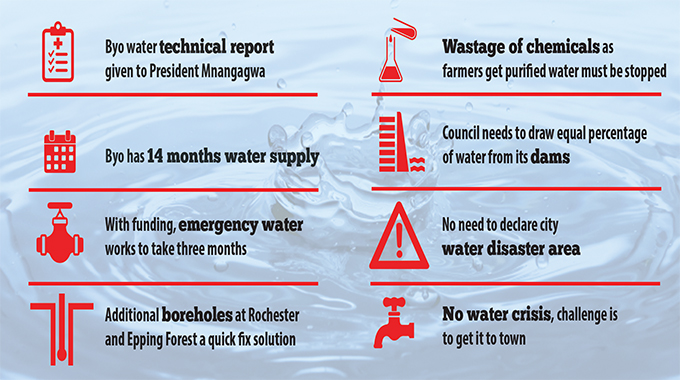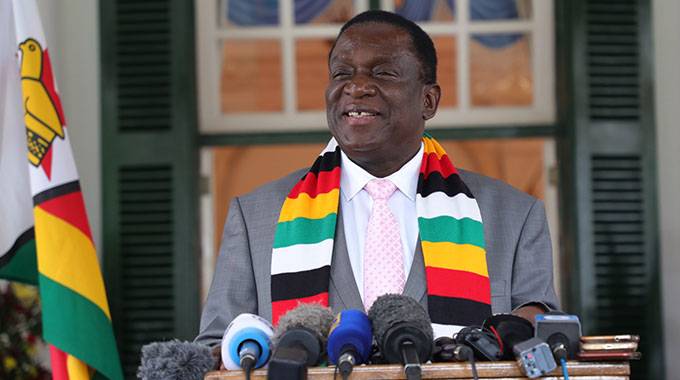President intervenes in Bulawayo water crisis

Thandeka Moyo-Ndlovu, Chronicle Reporter
PRESIDENT Mnangagwa has been engaged over Bulawayo water woes and Government has started implementing a plan to solve the crisis.
To that end, consultant engineers have been roped in to come up with solutions.
The President has since indicated that the water problems must be addressed as a matter of urgency, a development that will see Finance and Economic Development Minister Mthuli Ncube visiting the city today where presentations would be made on funding that is needed to address the water challenges.
The high-level intervention follows an announcement by Bulawayo City Council (BCC) that residents will now receive running water only once a week.
The local authority announced in a statement yesterday that it had decommissioned its third supply dam, Lower Ncema, making it the third to be decommissioned after Upper Ncema and Umzingwane dams. The development leaves Insiza, Inyankuni and Mtshabezi dams supplying the city with 94 megalitres (ML) of water per day against the daily average demand of 155 ML. The reduced water supply has necessitated a 144-hour weekly water shedding programme.

President Mnangagwa
The weekly water shedding exercise started last year in February at 48 hours, before it was increased to 72 hours then 108 hours up to 12 hours per week.
Yesterday, Local Government and Public Works Minister July Moyo, Bulawayo Provincial Affairs Minister, Cde Judith Ncube, Deputy Minister of Lands, Agriculture, Water, Climate and Rural Settlement Douglas Karoro and the Deputy Minister of Finance and Economic Development Clemence Chiduwa met with Bulawayo City Council councillors and management.
Minister Moyo said he had held a meeting with President Mnangagwa and he was committed to solving the city’s water problems.
He said consultant engineers had been engaged and concluded that the water problems facing the city could be solved even with only three functional supply dams.
The Minister said it is not yet necessary to declare the water crisis an emergency as it had been proven that with technical and financial resources, the situation could improve after three months.
In February the local authority applied to Government to declare the city’s water crisis an emergency to enable development partners to mobilise resources towards provision of water.
“I had a meeting with President Mnangagwa on Monday where we discussed the Bulawayo water crisis. Upon our deliberations I asked for time to visit the city before my colleague Minister Perrance Shiri could declare this crisis an emergency,” said Minister Moyo. “We then decided to engage Engineer Paul Kruger who from Monday has visited all supply dams and came up with his analysis and suggestions. Those three dams can last us for nine months but if properly synchronised they can last us for 14 months.”
The Minister said President Mnangagwa had said perennial water problems in Bulawayo must be solved.
“We have to move as the President wishes. There is still some technical work that the consultants have given to me and the President with regards to the amount of energy of your pumps versus what you get from the ground so that we can maximise the monies that we have to have. The efficient use of money is absolutely critical and let’s look at it when we meet with engineers,” he said.
“It appears to me there is consensus in terms of technical work that Bulawayo has not run out of water, yet Bulawayo City Council needs water. The catchment areas have not run out of water either in the aquifer area, or supply dams that is clear to all of us. What now remains because of that consensus of the technical work is for us as leaders to pronounce that these things are solvable to give hope to our people, that we can solve this because it is solvable. It can be solvable technically and financially and that is what we now have to mobilise.”
The Minister said before he leaves the city today, he will ensure that there is an agreement on the work that must be done as well as funding issues.
“Then a presentation is made tomorrow morning when the Minister of Finance comes before he visits the areas that he wants to see,” he added.
The Minister said according to the report by consultants council is spending much money on chemicals such as aluminum sulphate and others to treat the water which some farmers use for irrigation.
There was a recommendation for farmers not to use purified water for irrigation.
In his presentation, Eng Kruger said there is no water crisis in Bulawayo and the only challenge is to get the available water into the city. He said the available water can last the city for up to 14 months.
He said additional boreholes at Rochester and Epping Forest are quick fix solutions to Bulawayo’s water problems. Eng Kruger said with funding, emergency water works will take three months.
“So, the water is in the system, the challenge is to have the water and I’m talking about the southern part of the city, the water in Bulawayo area is there and we are not under crisis for water. The crisis is to get it to town,” he said.
He said authorities must address the supply of treated water to farmers who use it to irrigate cabbages and tomatoes. The engineer said farmers should be given raw water instead.
He said there must also be a decision to address competing interests on the need of water by Bulawayo residents and farmers.
“In Nyamandlovu it’s the same problem again and it is that we share the water with local farmers for flood irrigation and they are asked not to irrigate until after 3PM but farmers being farmers will not adhere,” he said. Eng Kruger said council needs to draw equal percentages of water from its dams.
The engineer said too much water was being drawn from Upper and Lower Ncema dams thereby putting more pressure on the infrastructure, the pipes and the pumps to supply the short remaining water. He said to address that, the water in the whole system must be drawn proportionally.
“One of the other issues we are having is we need to understand that Lower and Upper Ncema, Insiza and Inyankuni and Mtshabezi have one water body. It is one resource. At the beginning of the season we must allocate what percentage we should get from this dam and the other dam so we finish the season with more or the same level,” he said.









Comments